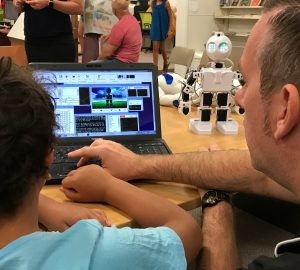Choosing the Right Technology for Your Library
By administrator | 10 March 2017
Is your community crying out for new technologies? Want to get started with coding and robotics programming in your library? Got money to spend but not sure where to start?
Selecting the right technologies is important both to make sure your community has the capacity to engage with the devices, and that your library space and staff are able to support the new offering. If your library is just starting out providing STEM (Science, Technology, Engineering and Maths) activities, it may not be best to spend all your funding on a single $8000 tech toy.

You might have money to buy some new gadgets, but do you have the laptops and tablets needed to control them?
The place to start is by reviewing the technology your library already offers – have you got computers? IPads? Ozobots? What is the uptake of these devices by your community? Once you’ve determined whether your community has a high uptake of technology or only occasionally makes use of your technology offerings, you’re ready to do some consultation and find out what additional technology the community might be interested in accessing through your library.
Be sure to take your time and do a bit of research. Don’t just buy something because you heard of a library somewhere that did something with a robot and you thought was incredible. If there’s a particular gadget you’re interested in, find out who else is using it and what sort of outcomes they’re achieving. Don’t be afraid to reach out and contact another library or institution to speak to them about both the positive and negative experiences they’ve had with technology. If they say that they’ve had great successes, but only through extensive troubleshooting and overcoming a steep learning curve, you may choose to reconsider your initial impulse to purchase.
Also consider who will be responsible for maintenance and care of the devices once they arrive at your library. Will there be one staff member who ensures everything is charged and ready to go for programming activities? Will one person be responsible for learning and developing technology-focused sessions, and then share their knowledge with the rest of the staff?
Once you’ve worked out how to meet the ongoing operational needs, it’s time to start dreaming up some activities you’d like to run when your new tech arrives. Consider which age range you’d like to target. Is this a technology accessible by all age groups? Can you adapt its functionality to suit a broad range of activities? Hopefully some of your research has already identified a few activities you can replicate. Here’s a link to some of the technologies currently available and being used by libraries.

WATCH THIS: Colorado State Library's Six Factors to Consider Before Choosing a Technology
Good programming uses the functionality of the device to supplement an already engaging activity. By doing this it broadens the range of sessions you can run with your new tech toys. Can you partner with the local school to expand on an idea students are exploring? Are you offering the same robotics that the school is already using, and need to present them in a different context?
By applying some critical thinking before you purchase, you’ll make sure your exploration into STEM programming will be fun and engaging for both library staff and your community.
Both the WELCOME toolkit and the Creative Spaces Impact Framework can help guide your thinking as you’re considering purchase of new technologies.
Also use your free Lynda.com access to check out Betsy Corcoran’s advice for schools on how to choose the right technologies
Comments
Your email address will not be published.
We welcome relevant, respectful comments.